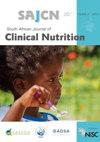处方模式的维生素D和类似物在私人保健患者人口在南非
IF 0.6
Q4 NUTRITION & DIETETICS
引用次数: 1
摘要
大量研究表明维生素D在预防骨骼疾病、支持免疫系统以及预防和减轻癌症方面的益处。直到最近,补充剂一直被认为是不必要的。尽管如此,鉴于新出现的证据,一些从业者正在将维生素D及其类似物(解剖治疗化学(ATC)分类代码A11CC)添加到他们的处方中。因此,目的是确定南非维生素D的医疗保险处方模式。方法:对2018年南非医疗保险管理人员数据库进行回顾性、横断面药物利用研究。提取ATC亚群A11CC中的产品(维生素D及其类似物)并进行分析。结果:2018年共有302名患者收到了1164张维生素D或类似物的处方。患者平均年龄47.14 (SD = 24.03)岁,以女性居多(58.28%)。非常年轻的患者和中年患者接受了大部分处方。使用频率最高的是麦角钙化醇(A11CC01)(59.79%),其次是阿法骨化醇(A11CC)、骨化醇(A11CC05)和骨化三醇(A11CC04)。麦角钙化醇5万IU片是最常用的商品名产品(59.45%),其次是阿法骨化醇胶囊(21.31%)。结论:维生素D适用于各个年龄段。维生素D的补充主要是在非常年轻和年龄较大的人群中开的,这表明他们需要额外的补充。与缺乏性疾病的治疗相比,额外补充维生素D的费用相对较小,因此补充维生素D可以以很少的费用对长期健康产生广泛而积极的影响。本文章由计算机程序翻译,如有差异,请以英文原文为准。
Prescribing patterns of vitamin D and analogues in a private healthcare patient population in South Africa
Introduction: Numerous studies show the benefits of vitamin D: in the prevention of bone disease, supporting the immune system and the prevention and mitigation of cancer. Until recently, supplementation has been deemed unnecessary. Nonetheless, in the light of emerging evidence, some practitioners are adding vitamin D and its analogues (Anatomic Therapeutic Chemical (ATC) classification code A11CC) to their prescriptions. Therefore, the aim was to determine the medical insurance prescribing patterns of vitamin D in South Africa. Methods: A retrospective, cross-sectional drug utilisation study was conducted on a South African medical insurance administrator database for 2018. Products in ATC subgroup A11CC (vitamin D and analogues) were extracted and analysed. Results: A total of 302 patients received 1 164 prescriptions for a vitamin D or analogue product during 2018. The average age of patients was 47.14 (SD = 24.03) years, and the majority were female (58.28%). Very young patients and middle-aged patients received most of the prescriptions. Ergocalciferol (A11CC01) was the most frequently prescribed (59.79%), followed by alfacalcidol (A11CC), colecalciferol (A11CC05) and calcitriol (A11CC04). Ergocalciferol 50 000 IU tablets comprised the most frequently prescribed trade name product (59.45%), followed by alfacalcidol capsules (21.31%). Conclusion: Vitamin D was used across the age range. Vitamin D supplementation was primarily prescribed in the very young and older age groups, suggesting their need for additional supplementation. As the cost of additional supplements is relatively small compared with the treatment of deficiency disorders, vitamin D supplementation could have broad and positive effects on long-term health for very little outlay.
求助全文
通过发布文献求助,成功后即可免费获取论文全文。
去求助
来源期刊

South African Journal of Clinical Nutrition
NUTRITION & DIETETICS-
CiteScore
2.50
自引率
9.10%
发文量
21
期刊介绍:
1.The Journal accepts articles from all basic and applied areas of dietetics and human nutrition, including clinical nutrition, community nutrition, food science, food policy, food service management, nutrition policy and public health nutrition. 2.The Journal has a broad interpretation of the field of nutrition and recognizes that there are many factors that determine nutritional status and that need to be the subject of scientific investigation and reported in the Journal. 3.The Journal seeks to serve a broad readership and to provide information that will be useful to the scientific community, the academic community, government and non-government stakeholders in the nutrition field, policy makers and industry.
 求助内容:
求助内容: 应助结果提醒方式:
应助结果提醒方式:


